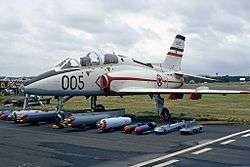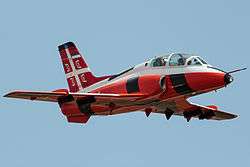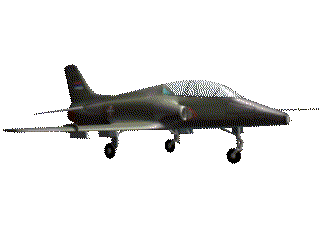Soko G-4 Super Galeb
| G-4 Super Galeb | |
|---|---|
.jpg) | |
| A Serbian Air Force G-4 Super Galeb | |
| Role | Military trainer aircraft |
| Manufacturer | SOKO |
| Design group | Aeronautical Technical Institute |
| First flight | 17 July 1978 |
| Introduction | 1983 |
| Status | In service |
| Primary user | Serbian Air Force |
| Produced | 1984–1991 |
| Number built | 85[1] |
| Unit cost |
$4.2 million (in 2010 U.S. dollars)[1] |
The Soko G-4 Super Galeb (English: Super Seagull), also referred to as N-62, is a Yugoslav single-engine, advanced jet trainer and light ground-attack aircraft. The G-4 was designed by the Aeronautical Technical Institute at Žarkovo and manufactured by the SOKO aircraft factory in Mostar as a replacement for the Soko G-2 Galeb in service with the Yugoslav Air Force (Serbo-Croatian: Ratno vazduhoplovstvo i protivvazdušna odbrana – RV i PVO; Croatian: Ratno zrakoplovstvo i protuzračna obrana - RZ i PZO.). Production started in 1984 and lasted until the breakup of Yugoslavia in 1991. A total of 85 aircraft were built, six of which were exported to Myanmar.
During the Yugoslav Wars, RV i PVO G-4s carried out ground-attack sorties, with four being lost to enemy air defences. In 1992 the remaining aircraft were relocated to Serbia and Montenegro where they entered service with the Air Force of the new FR Yugoslavia. A single G-4 was left over to the Republika Srpska Air Force.
Design and development

The G-4 Super Galeb was developed as a replacement for the G-2 Galeb, which had been the most commonly used jet trainer aircraft of the Yugoslav Air Force up until 1990. The first of two prototypes was completed by early 1978. Following completion of the initial testing phase, the first flight was achieved on 17 July 1978 and the first of six pre-production aircraft on 17 December 1980. These and the first prototype were designated G-4 PPP, and had fixed tailplanes with inset elevators and no anhedral.[2] Production examples (and the second prototype) were designated G-4 and featured an all-moving anhedral tailplane and comprehensive avionics improvements.[2] The G-4 first flew in 1983 and has been ordered in large numbers for the Yugoslav Air Force.
The G-4 features a low wing monoplane design with slightly tapered wings.[2] The aircraft is 12.25m long and 4.3m high, with a wingspan of 9.88m.[2] It weighs 3,250 kg when empty and can carry 1,882 kg of fuel.[2] The aircraft is fitted with a short nose cone, rounded fuselage, conventional empennage, semicircular air intakes, vertical tailfins, rudder, ailerons, horizontal stabilisers and fuel tanks at the square tips.[2] The G-4 its performance is considerably improved by the introduction of a more powerful version of the Rolls-Royce Viper 632-46 turbojet.[2] The cockpit is fitted with two ejection seats with the rear seat slightly elevated to render all round clear visibility.
The G-4 saw some combat during the Yugoslav Wars. In total, three G-4s were shot down, all pilots ejecting safely. During the NATO bombing of Yugoslavia, seven G-4s of the Leteće zvezde aerobatics team were destroyed at Golubovci Air Base.[3]
Variants

- G-4: Advanced jet trainer and light ground-attack aircraft.
- G-4Š: Unarmed jet trainer.
- G-4T: Target puller.
- G-4M: Upgraded avionics and hardpoints, missile rail added to wingtips. Avionics include a Zrak ENP-MG4 HUD incorporating a Rudi Cajavec ENS-MG4 electronic sight, a gyro platform, multi function displays, and an optional chaff/flare dispensers. The inner hardpoints are rated at 500 kg, while the outer ones are rated at 350 kg, giving a maximum disposable load of 1,800 kg. Normal takeoff weight is 4,971 kg as a trainer, with a maximum takeoff weight of 6,400 kg in the attacker configuration, the maximum speed in "clean" configuration is 865 km/h at 10,000 m and 900 km/h at 4,000 m, with a ferry range of 2,900 km with drop tanks; range of 1,800 km with standard fuel, reduced to 1,200 km with cannon pack, four BL755 cluster bombs and two AAMs, maximum rate of climb at sea level of 1,800 m per minute, and a service ceiling of 12,500 m.[4]
- G-4MD: Further development of G-4M upgrade including: LCD flight screens, HOTAS, HUD, integrated mission computers, distance measuring equipment, GPS-based navigation systems, identification friend or foe, navcomm units, mission records, and VHF omni-range and instrument landing systems. Integration of guided weapons, countermeasures and targeting systems is also scheduled as part of the upgrade.[5]
Operators


Former operators


.svg.png)
Notable accidents
- On 24 September 2008, while practicing for an upcoming airshow a Serbian Air Force G-4 crashed at Batajnica Air Base near Belgrade, killing the pilot.[9]
- On 07.04.2017 one G-4 Serbian Air Force crashed at 10.30 hours local time in the vicinity of the village of Slatina, some 60 km south-west of capital Belgrade, in western Serbia. Having failed to eject, killed in this accident were Lt.Col Nenad Ćulibrk (49) from the Air Force and Air Defense Command and Cap. Dejan Pandurović (39) from Batajnica-based 252nd Training squadron of the 204th Air Force Brigade.
- On 11.04.2018 one G-4 Serbian Air Foce crashed at 9.30 hours local time near the Kovačica village. One pilot died[10].
Specifications (G-4M)

Data from Jane's All The World's Aircraft 1993-94[11]
General characteristics
- Crew: 2
- Length: 12.25 m (40 ft 2 in)
- Wingspan: 9.88 m (32 ft 5 in)
- Height: 4.30 m (14 ft 1 in)
- Wing area: 19.5 m2 (210 sq ft)
- Aspect ratio: 5.01
- Empty weight: 3,250 kg (7,165 lb)
- Gross weight: 4,760 kg (10,494 lb)
- Max takeoff weight: 6,330 kg (13,955 lb)
- Fuel capacity: 1,882 kg (maximum internal and external fuel)
- Powerplant: 1 × Rolls-Royce Viper 632-46 , 17.8 kN (4,000 lbf) thrust
Performance
- Maximum speed: 920 km/h (572 mph; 497 kn) clean @ 6,000 m (13,000 ft)
- Cruise speed: 550 km/h (342 mph; 297 kn) @ 6,000m
- Stall speed: 180 km/h (112 mph; 97 kn) dirty
- Never exceed speed: 921 km/h (572 mph; 497 kn) 0.9M @ 11,000m
- Range: 1,900 km (1,181 mi; 1,026 nmi) Internal fuel
- Combat range: 1,300 km (808 mi; 702 nmi) with cannon pack and four BL755 cluster bombs (combat radius 485 km)
- Ferry range: 2,500 km (1,553 mi; 1,350 nmi) maximum internal and external fuel
- Service ceiling: 12,850 m (42,160 ft) Service ceiling (Altitude at which maximum climb rate reduces to 100 ft/min)
- g limits: -4.2 to +8
- Rate of climb: 31 m/s (6,100 ft/min)
- Time to altitude: 6 minutes to 8,000m
Armament
- 1x GSh-23L 23 mm cannon in ventral gun pod.
- 2x Inner pylons 350 kg (770 lb)capacity.
- 2x Outer pylons 250 kg (550 lb) capacity.
- 1x Centreline pylon 400 kg (880 lb) capacity (G-4M).
- 2x Wingtip missile rails (G-4M).
Avionics
Standard communication and navigation equipment, plus (fire control and weapons management) Ferranti ISIS D-282 gyro sight, and (defensive sensors and systems) Iskra SD-1 RWR; there is also provision for a reconnaissance pod with cameras and an IR line scanner.
Aircraft on display
- Serbia
- Museum of Aviation (Belgrade) in Belgrade - There are four Soko G-4 Galebs on display.[12]
See also
- Leteće zvezde (flying stars - aerobatics team)
Related development
Aircraft of comparable role, configuration and era
- Aermacchi MB-339
- Aero L-39 Albatros
- AIDC AT-3
- BAE Systems Hawk
- CASA C-101
- Dassault/Dornier Alpha Jet
- FMA IA 63 Pampa
- IAR 99
- Kawasaki T-4
- PZL I-22 Iryda
References
- 1 2 Muzej vazduhoplovstva. "N-62 Super Galeb G-4". Muzej vazduhoplovstva (Aeronautical museum-Belgrade).
- 1 2 3 4 5 6 7 Military Factory. "SOKO G-4 Super Galeb (Super Seagull) Light Attack / Advanced Trainer (1983)".
- ↑ Bozinovski, Igor (29 June 2007). "Serbia's Stars in aerobatic display". London: Flightglobal.
- ↑ https://web.archive.org/web/20071217194912/http://wiki.airserbia.com/show_image.php?id=7&scaled&scalesize=0&nocount=y. Archived from the original on 17 December 2007. Missing or empty
|title=(help) - ↑ Salinger, Igor (11 August 2008). "Serbian air force targets fleet modernisation". Flightglobal.
- 1 2 "World Air Forces 2013" (PDF). Flightglobal Insight. 2013. Retrieved 26 February 2013.
- ↑ "Na prodaju posljednja četiri borbena aviona". Vijesti. 27 October 2012. Retrieved 31 October 2012.
- ↑ http://tangosix.rs/2016/26/04/istorija-modernizacije-aviona-g-4-super-galeb/
- ↑ "VS plane crashes, kills pilot". B92. 24 September 2008. Archived from the original on 30 October 2014. Retrieved 24 July 2009.
- ↑ "Serbian Soko G-4 Super Galeb crashes | Jane's 360". www.janes.com. Retrieved 2018-04-11.
- ↑ Lambert 1993, pp. 587–589.
- ↑ "Museum of the Yugoslav Air Force". Aviation Museum.
Sources
- Gunston, Bill (2001). The Encyclopedia of Modern Warplanes: The Development and Specifications of All Active Military Aircraft. MetroBooks. ISBN 978-1-58663-207-6.
- Gunston, Bill (1995). The Encyclopedia of Modern Warplanes: The Development and Specifications of All Active Military Aircraft. MetroBooks.
- Gunston, Bill (1987). The Encyclopedia of World Air Power (Revised ed.). Crescent Books.
- Lambert, Mark (1993). Jane's All the World's Aircraft, 1993-94. Jane's Information Group. ISBN 978-0-7106-1066-9.
External links
| Wikimedia Commons has media related to Soko G-4 Super Galeb. |
- Aerosvet Magazine; (Entry from the International Directory of Design)
- G-4 Super Galeb No.23405